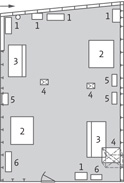| |
 |
|
|
|
| |
 |
Sub-Lieutenant
Heinz Aengeneyndt
Communication Officer, 7. Division
* 11.03.1914 in Gelsenkirchen (Westphalia) - † 27.5.1941
|
 |
|
|


Germany (1914)
Sources:
Ralf Schnitzler (Hobbyhistorican) / Wetzlar
Franz Halke †
Adolf Eich †
|
Heinz Aengeneyndt was born on March 11, 1914 in the Westphalian city of Gelsenkirchen. He completed his schooling with a Abitur. The now twenty-three-year-old later decided to join the navy and applied to become an officer. After a thorough entrance examination, he was accepted as an officer candidate in the Kriegsmarine and was drafted with the crew 37 B on October 1, 1937. Since the school period leading up to the Abitur was shortened by one year in 1937, twice as many high school graduates applied for officer careers in 1937 as usual. Therefore, the naval command decided to draft two crews per year instead of the usual one: Crew 37 A and 37 B.
The service began for Heinz Aengeneyndt and his crewmates with the 2nd Schiffsstammabteilung of the Baltic on the Stralsund Island of Dänholm. The basic training there, which took place during the cold seasons of autumn and winter, lasted a total of five months. With the cool temperatures, which sometimes dropped to below zero degree Celsius, the recruits were always happy when the service, which was characterized by marches and field exercises, drills and other activities, came to an end and they went back inside to the barracks.
|
|
|
Sailing training ship
Horst Wessel
Layed down: |
15.02.1936 |
Launch: |
13.06.1936 |
Commission: |
17.09.1936 |
End: |
still in service |
ment: |
1.600 ts |
Size: |
89 m x 12 m |
Crew: |
290 men |
|
The Horst Wessel was built according to slightly different plans to relieve the pressure on the Gorch Fock. From 1936 she sailed as a sailing training ship with officer candidates from the Navy. During the war she lay idle in Kiel most of the time. As reparations she was transferred to the USA in 1946 and put into service by the US Coast Guard under the name Eagle. She still sails for them today and young officer candidates still learn the seamanship basics of their profession on her.

|
Heinz Aengeneyndt then underwent four months of training on board the sailing training ship Horst Wessel. During a long voyage that the ship undertook together with the sailing training ship Albert Leo Schlageter, the young officer candidates traditionally learned the nautical basics of their future craft. But they also learned to appreciate traveling to distant foreign countries — the trip went all the way to the West Indies and was, for many young officer candidates, their first travel abroad.
From the Horst Wessel Heinz Aengeneyndt continued on to the school cruiser Emden in the summer of 1938. With this, Heinz Aengeneyndt set off on another great journey on July 26, 1938. It was to be Emden's last peaceful trip abroad. Via Norway and Iceland, after a short stop in Reykjavik, they went into the open Atlantic. The Emden next called at the Spanish port of Vigo and from there crossed the Atlantic, via the Azores to the Bermuda Islands. On the way back to Wilhelmshaven she stopped at Madeira. On October 10, 1938, after a short stopover at home, she went back into the Atlantic. The destination of the second part of the trip was the Mediterranean and the Black Sea. On the trip the ports of Constanta (Romania), Varna (Bulgaria), Istanbul (Türkiye), the Greek island of Rhodes and again Vigo were called at. On December 15, 1938, the Emden finally returned to Wilhelmshaven after almost five months of travel abroad. Heinz Aengeneyndt served on board the Emden until the end of February 1939, before he and his crewmates were assigned to the officer course at the Mürwik Naval School. Before that, they had to complete the midshipman exam and were then awarded the portepee as newly promoted midshipmen. The next six months, which the officers' course took up, consisted mainly of theoretical lessons.
Towards the end of school, the war began and even if the young officer candidates almost all wanted to be able to take part in the victories in war that followed for the german side at frist, they still had to hold back and continue learning.
Heinz Aengeneyndt attended a two-month artillery course at the Kiel Naval Artillery School before he was commanded abord the light cruiser Karlsruhe at the end of 1939. The ship had been in the Wilhelmshaven naval shipyard for over a year for overhauling work. On November 13, 1939, the Karlsruhe was put back into service by her new crew. The midshipman Heinz Aengeneyndt now underwent the following accelerated testing and training program in order to report the cruiser as ready for war as quickly as possible. It can be assumed that he remained on board until the sinking of the Karlsruhe on April 7, 1940 during the Norwegian campaign and was then directly assigned to the battleship Bismarck.
|
|
|

Aft artillery calculation center
(Oberes Plattformdeck,
Abt. VII BB)
1 |
Machine |
2 |
Directional and altitude wise receiver |
3 |
Shot data calculator |
4 |
Fan |
5 |
Firesignal transmitter |
6 |
Switchboard |
1 Among those waiting was Lieutenant Burkard Freiherr von Müllenheim-Rechberg (see page 184), who was in command in the aft artillery commandpost.
|
On May 1, 1940 he was promoted to sub-lieutenant, which completed his officer training. On the Bismarck, Heinz Aengeneyndt took the position of communication officer for the heavy artillery in the Bismarck's aft artillery computing center. He had a good reputation among his subordinate soldiers and was considered a good-natured superior. So he allowed them to smoke on the station and they could take turns stretching their legs on the upper deck during the quiet phases of the "Rheinübung" operation, remembers one of the survivors.
Later, after the last battle had broken out and the own guns had already fallen silent, Heinz Aengeneyndt and his men sat in front of their devices in the aft artillery calculation center, without any connection to the outside world. The lights were still on and the alarm bells were ringing, but the telephones were no longer working. Disquiet slowly spread through the room. The impacts could still be heard above, but no one knew exactly how bad the ship was. Finally Heinz Aengeneyndt sent a man to clarify what was going on. After a few minutes he came back and reported that the scuttling had already begun and that the order had been given to abandon ship. During the subsequent attempt to escape from the sinking ship, Heinz Aengeneyndt soon discovered that the escape routes had become impassable due to debries and fires. One of his men suggested climbing through the connecting shaft up to the aft artillery commandpost. After a short hesitation, Heinz Aengeneyndt followed his men into the shaft. Once at the top, however, they had to contend with a locked hatch, which was finally opened from the other side after a few knocks. Several men had already gathered in the aft artillery commandpost and were waiting for the shelling to end.1
Finally they left the room and jumped into the water. While four of his men were able to get themselve rescued by the two British ships that came to help, Heinz Aengeneyndt was unable to do so. He died on May 27, 1941 at the age of 27.
|
|
|